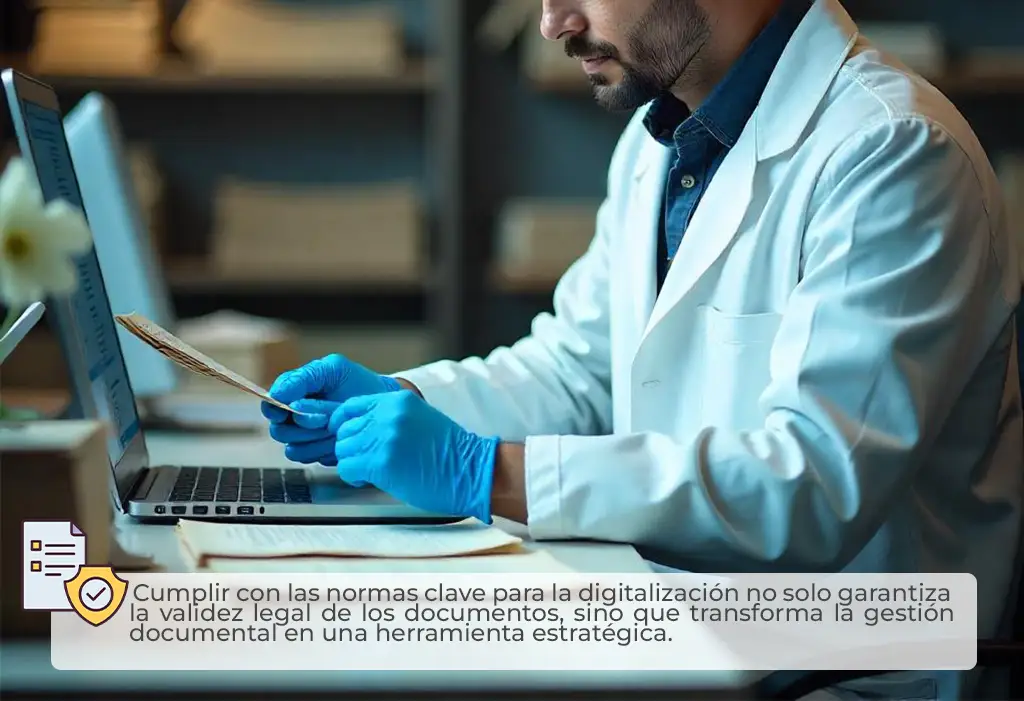ChatGPT Plus The conversion of physical documents to digital formats has shifted from being an option to becoming an obligation for entities seeking to optimize their operational performance and reduce costs. In today’s context, where digital transformation is advancing rapidly, the regulatory and technical handling of electronic documents takes on special importance. This article delves into the key regulations for the digitization of archival documents in Colombia, providing practical guidance for their implementation in accordance with current legal frameworks.
What does document digitization encompass according to Colombian regulations?
From a regulatory perspective, digitizing documents goes beyond simply scanning paper files; it involves structured processes that ensure their authenticity, integrity, and availability. Regulated digitization includes everything from image capture to indexing, classification, and storage in accordance with the provisions of the Agreement 060 of 2001 from the National Archives of Colombia (AGN), one of the key regulations for digitization in Colombia. Additionally, the guidelines of Law 594 of 2000 must be observed, as it sets forth the guiding principles for document management.
This regulatory procedure allows organizations not only to reduce the volume of physical archives but also to apply archival criteria to the information life cycle. Consequently, an appropriate strategy should consider which documents will be digitized, under what technical and legal criteria, how their access and preservation will be ensured, and who will be authorized to handle that information.
Documents subject to regulated digitization
Colombian regulations allow for the digitization of a wide range of documents, as long as the principles of authenticity, reliability, and long-term preservation are respected. Among the types of documents that can be digitized are:
-
Administrative documentation
Contracts, resolutions, minutes, reports, and other records that reflect internal activities.
-
Legal documentation
Notarial records, public deeds, property titles.
-
Citizen service documentation
Petitions, complaints, claims, and service requests.
-
Clinical documentation
Medical records and exam results, whose digitization must comply with key regulations such as Resolution 1995 of 1999 from the Ministry of Health.
To comply with the parameters set by the AGN, it is essential to carry out a preliminary document assessment that enables the selection and prioritization of the materials to be digitized, identifying those with historical, legal, or administrative value.
Advantages of standards-compliant digitization
Digitizing under the guidelines of the Colombian legal framework and in compliance with key regulations for digitization offers significant benefits—not only from an operational standpoint but also in terms of regulatory compliance and the protection of citizens' rights. The main benefits include:
- Reduction of logistical expenses: By eliminating the need for massive physical storage, costs related to infrastructure, supplies, and preservation are significantly reduced.
- Quick and efficient access to information: Properly organized and described digitized documents can be retrieved within seconds.
- Strengthening of public and private management: The availability of information streamlines processes and improves service to users and clients.
- Document security: By complying with regulations such as Law 527 of 1999 on data messages and digital signatures, the legal validity of digitized documents is ensured.
These advantages are directly linked to the organization's ability to implement electronic document management systems that align with the key regulations for digitization issued by the AGN and other regulatory entities.

Digitization and institutional sustainability
One of the goals of the Colombian regulatory framework is to promote the efficient and sustainable management of archives. By reducing paper use and encouraging digital preservation, public and private entities contribute to institutional sustainability policies. This aligns with the Digital Government strategy, which aims to modernize public administration through the responsible use of information technologies.
Adopting regulated digitization processes also demonstrates a commitment to transparency, environmental responsibility, and administrative efficiency—key factors in strengthening public trust and organizational reputation. In this regard, the key regulations for digitization serve as a guide to ensure these efforts are consistent and effective.
Regulatory pillars for proper implementation
An effective transition toward regulated archive digitization requires attention to several essential elements, all framed within the key regulations for digitization that Colombia has adopted as a reference.
1. Design of a document policy in accordance with Law 594 of 2000
Every entity must have a Document Management Policy that incorporates digitization as a strategic pillar. This policy should be framed within the Integrated Planning and Management Model (MIPG) and aligned with the Document Management Program (PGD), as required by Decree 1080 of 2015.
An archival assessment, the identification of document series, and the application of retention schedules are essential to determine which documents should be digitized and under what technical and legal conditions, in accordance with the key regulations for digitization.
2. Adoption of validated technologies compatible with regulations
It is essential that digitization tools—such as scanners, OCR, and document management software—meet technical requirements that ensure the authenticity and traceability of digitized documents. The use of standardized archival metadata is a practice recommended by the AGN and is part of the key regulations for document digitization.
Among the technical requirements to be considered are:
- Recommended minimum scanning resolution (300 dpi).
- Accepted formats for preservation (PDF/A, TIFF).
- Reliable and redundant storage systems.
- Efficient search capabilities and immediate retrieval.
3. Staff training with a regulatory focus
Staff training must go beyond the technical use of tools. It is essential to provide education in archival principles, applicable legal regulations, and best practices in document management. External Circular No. 003 of 2019 from the AGN emphasizes the need to assign properly trained personnel responsible for document management.
Involving the work team in the design and execution of processes fosters a sense of ownership and improves the adoption of new methods, reducing resistance to change. These actions must be guided by the current key regulations for digitization.
Digitization as a regulatory and strategic pillar
Document digitization should not be understood solely as a technological advancement, but as a process governed by key regulations for digitization aimed at ensuring the preservation, legality, and long-term accessibility of information. It is both a legal obligation and a strategic opportunity to transform the way institutional archives are managed.
Organizations such as the National Archives of Colombia, the Ministry of ICT, and the Superintendencies have been developing reference frameworks, standards, and guidelines that guide digitization based on criteria of interoperability, quality, and administrative efficiency. In fact, initiatives like the Digital One-Stop Window or the Electronic Health Record require compliance with specific key regulations for digitization to ensure the legality of electronic documents.
Regulatory and technological projections
The digitization of archives in Colombia is progressing alongside increasingly sophisticated technologies and regulatory frameworks. Some key projections include:
1. Inclusion of artificial intelligence under traceability standards
Artificial intelligence is emerging as a valuable ally for automating document processes, as long as compliance with current regulations is maintained. AI can assist in the automatic classification of files, content recognition, and metadata validation, but it must be implemented within controlled frameworks that ensure transparency and data protection. All of this must be carried out in accordance with the key regulations for digitization.
2. Consolidation of cloud storage in compliance with data protection laws
The use of cloud platforms must be governed by Law 1581 of 2012 on personal data protection and ensure adequate security and backup conditions. Services should offer certifications such as ISO 27001 and allow for file recovery at any time without compromising their integrity, as required by the key regulations for document digitization.
3. Greater emphasis on regulatory usability and accessibility
The trend points toward document management systems not only meeting legal requirements but also being user-friendly and accessible to all users, including individuals with disabilities. This focus on accessibility is reflected in public policies such as CONPES 3975 of 2019, which promotes inclusive digital transformation, supported by key regulations for digitization that ensure equitable access to information.
Get ahead of the future by complying with the key regulations for digitization!
Implement secure, efficient digitization processes aligned with Colombian regulations. At Protech Ingeniería, we guide you every step of the way to transform your physical files into reliable, accessible, and legally valid digital information.
Take the step now.
Contact us today and turn document management into a strategic advantage.








